See also
| This disambiguation page lists articles associated with the title As the Earth Turns. If an internal link led you here, you may wish to change the link to point directly to the intended article. |
As the Earth Turns may refer to:
| This disambiguation page lists articles associated with the title As the Earth Turns. If an internal link led you here, you may wish to change the link to point directly to the intended article. |

"Jabberwocky" is a nonsense poem written by Lewis Carroll about the killing of a creature named "the Jabberwock". It was included in his 1871 novel Through the Looking-Glass, and What Alice Found There, the sequel to Alice's Adventures in Wonderland (1865). The book tells of Alice's adventures within the back-to-front world of Looking-Glass Land.

Through the Looking-Glass, and What Alice Found There is an 1871 novel by Lewis Carroll and the sequel to Alice's Adventures in Wonderland (1865). Alice again enters a fantastical world, this time by climbing through a mirror into the world that she can see beyond it. There she finds that, just like a reflection, everything is reversed, including logic.

I Am Legend is a 1954 post-apocalyptic horror novel by American writer Richard Matheson that was influential in the modern development of zombie and vampire literature and in popularizing the concept of a worldwide apocalypse due to disease. The novel was a success and was adapted into the films The Last Man on Earth (1964), The Omega Man (1971), and I Am Legend (2007). It was also an inspiration behind Night of the Living Dead (1968).

Alice's Adventures in Wonderland is an 1865 novel by English author Lewis Carroll. It tells of a young girl named Alice, who falls through a rabbit hole into a subterranean fantasy world populated by peculiar, anthropomorphic creatures. It is considered to be one of the best examples of the literary nonsense genre. The tale plays with logic, giving the story lasting popularity with adults as well as with children.

Apocalyptic and post-apocalyptic fiction is a subgenre of science fiction, science fantasy, dystopian or horror in which the Earth's technological civilization is collapsing or has collapsed. The apocalypse event may be climatic, such as runaway climate change; astronomical, such as an impact event; destructive, such as nuclear holocaust or resource depletion; medical, such as a pandemic, whether natural or human-caused; eschatological, such as the Last Judgment, Second Coming or Ragnarök; or more imaginative, such as a zombie apocalypse, cybernetic revolt, technological singularity, dysgenics or alien invasion.

From the Earth to the Moon: A Direct Route in 97 Hours, 20 Minutes is an 1865 novel by Jules Verne. It tells the story of the Baltimore Gun Club, a post-American Civil War society of weapons enthusiasts, and their attempts to build an enormous Columbiad space gun and launch three people—the Gun Club's president, his Philadelphian armor-making rival, and a French poet—in a projectile with the goal of a Moon landing. Five years later, Verne wrote a sequel called Around the Moon.

Journey to the Center of the Earth, also translated with the variant titles A Journey to the Centre of the Earth and A Journey into the Interior of the Earth), is a classic science fiction novel by Jules Verne. It was first published in French in 1864, then reissued in 1867 in a revised and expanded edition. Professor Otto Lidenbrock is the tale's central figure, an eccentric German scientist who believes there are volcanic tubes that reach to the very center of the earth. He, his nephew Axel, and their Icelandic guide Hans rappel into Iceland's celebrated inactive volcano Snæfellsjökull, then contend with many dangers, including cave-ins, subpolar tornadoes, an underground ocean, and living prehistoric monsters from the Mesozoic and Cenozoic eras. Eventually the three explorers are spewed back to the surface by an active volcano, Stromboli, in southern Italy.
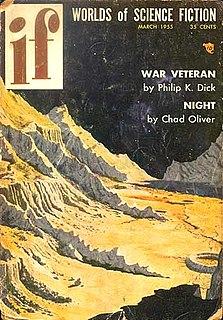
"War Veteran" is a science fiction short story by American writer Philip K. Dick. It was first published in If magazine in March 1955.
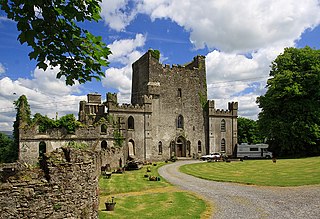
Leap Castle is a castle in Coolderry, County Offaly, Ireland, about 6 km north of the town of Roscrea and 10 km south of Kinnitty on the R421.

Not of This Earth is an independently made 1957 American black-and-white science fiction film produced and directed by Roger Corman, that stars Paul Birch, Beverly Garland, Morgan Jones, William Roerick, and Anna Lee Carroll. The film was written by Charles B. Griffith and Mark Hanna and was distributed by Allied Artists Pictures Corporation as a double feature with Attack of the Crab Monsters. Its theatrical release had a running time of 67 minutes, that was expanded to 70 minutes in 1962 for TV syndication.

Subterranean fiction is a subgenre of adventure fiction, science fiction, or fantasy which focuses on fictional underground settings, sometimes at the center of the Earth or otherwise deep below the surface. The genre is based on, and has in turn influenced, the Hollow Earth theory. The earliest works in the genre were Enlightenment-era philosophical or allegorical works, in which the underground setting was often largely incidental. In the late 19th century, however, more pseudoscientific or proto-science-fictional motifs gained prevalence. Common themes have included a depiction of the underground world as more primitive than the surface, either culturally, technologically or biologically, or in some combination thereof. The former cases usually see the setting used as a venue for sword-and-sorcery fiction, while the latter often features cryptids or creatures extinct on the surface, such as dinosaurs or archaic humans. A less frequent theme has the underground world much more technologically advanced than the surface one, typically either as the refugium of a lost civilization, or as a secret base for space aliens.

Lewis Carroll's books Alice's Adventures in Wonderland (1865) and Through the Looking-Glass (1871) have been highly popular in their original forms, and have served as the basis for many subsequent works since they were published. They have been adapted directly into other media, their characters and situations have been appropriated into other works, and these elements have been referenced innumerable times as familiar elements of shared culture. Simple references to the two books are too numerous to list; this list of works based on Alice in Wonderland focuses on works based specifically and substantially on Carroll's two books about the character of Alice.

Bones of the Moon is a novel by American writer Jonathan Carroll, depicting the real and dream life of a young woman, Cullen James. Like many of Carroll's works, this work straddles the horror and fantasy genres.

Alice's Adventures in Wonderland is a 1972 British musical film based on Lewis Carroll's 1865 novel of the same name and its 1871 sequel, Through the Looking-Glass, directed by Australian television producer-director William Sterling. It had a distinguished ensemble cast with a musical score by John Barry and lyrics, Don Black.
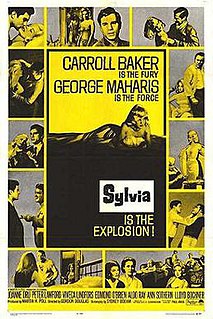
Sylvia is a 1965 American drama film directed by Gordon Douglas, written by Sydney Boehm, and starring George Maharis, Carroll Baker, and Peter Lawford. The film is based on the novel of the same name by E. V. Cunningham in 1960.
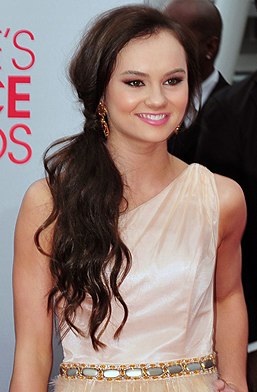
Madeline Carroll is an American actress and screenwriter.
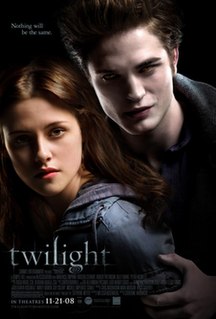
Twilight is a 2008 American romantic fantasy film based on Stephenie Meyer's 2005 novel of the same name. Directed by Catherine Hardwicke, the film stars Kristen Stewart and Robert Pattinson. It is the first film in The Twilight Saga film series. This film focuses on the development of the relationship between Bella Swan and Edward Cullen, and the subsequent efforts of Edward and his family to keep Bella safe from a coven of evil vampires.
Gladys Hasty Carroll was an American novelist active from the late 1920s into the 1980s. In her fiction and non-fiction, Carroll wrote about what she knew and people that she loved, especially those in the Southern Maine rural community of Dunnybrook, located in South Berwick, Maine. Carroll believed that the history of common folk mattered most and her works presented their stories.

Wonderland is the setting for Lewis Carroll's 1865 children's novel Alice's Adventures in Wonderland.

Transformers: Dark of the Moon: The Junior Novel is an adaptation of the 2011 film Transformers: Dark of the Moon written by Michael Kelly. For younger readers the violence featured in the movie is scaled down considerably and the book features a different ending than the one seen in the film to avoid spoilers as the novel was released before the movie was, although this could be contributed to the fact that the novel may have been based on an earlier version of the script than the one seen in the final film.